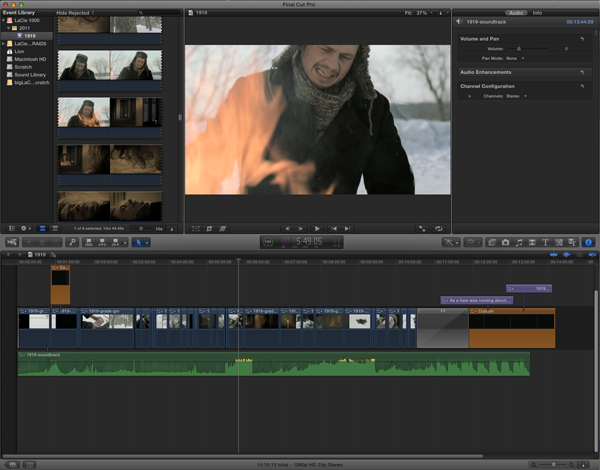Final Cut Pro X: Causes of Hysteria

Watching the hysteria that has unfolded on the network about the release of Final Cut Pro X, I would like to focus on its causes. This is my subjective view, the look of a man who has been for more than ten years now, sits at the assembly table.
When I was an editor, I tried all available and popular packages from Avid, Adobe, Apple, choosing Final Cut. This was done due to the fact that it was very close to my needs as a film editor: he worked quite quickly, supported all common input and output devices, worked with most popular formats. Everything in it was not bad, except for the very not very typical, for Apple products interface. This is not surprising, because the program was purchased from Macromedia, which has never been famous for high-quality interfaces.
Time passed, formats, carriers, principles of work with the material changed, along with this, generations of the program, seven major updates, and no development, but only work to improve the quality and stability of work. Only a few interesting features were added, no innovations. And changed as many as seven generations. For me, let's say, it is obvious that it could not go on like this. People have increasingly become instead of film use digital cameras that have written duplicates in separate files, if not at all on cameras with video recording function. The frame resolution increased, which entailed an increase in the volume of files and, consequently, the requirements for computer resources. Computers have long become 64-bit, in one word: the program didn’t meet modern requirements for performance or process organization.
')

Work on the 1919 short meter, shot on 35 mm, there was no difficulty in the work
Apple has made a big step forward, completely reworking the package, rewriting it again, integrating into it all the best that was in Final Cut, Shake, and Color, of course, one product cannot carry all the power of these products, but for solving everyday tasks, most users is optimal. The program turned out to be truly revolutionary, changing the principles of work with the material, organization of the process, and assembly of the timeline. Let's add here the speed and quality (exactly as Apple usually does) interface. This is the first version that awaits evolution, fouling with new and improved features, the implementation of which, in the current version, would greatly delay the release date. Seven do not wait for one, so they say, those who are investing in new technologies for shooting and production should not suffer, for the sake of those who still use Betacam and the like. In the end, they have the opportunity, along with their old equipment, to use old versions of the package. Apple is considering the possibility of selling licenses of the 7th version, taking into account the interests of users. Support for multi-cameras will appear in the near future, as well as the ability to import / export to XML. Of course, there is not and will not be possible to open projects created in the previous generation of the program, but this is quite logical, since this is a completely different, new program, incompatible with the previous ideology of track editing. No one bothers to keep both the old and the new version of the program on the same computer at the same time; All ahead. In the meantime, this is a fairly high-quality one, I repeat, which meets the requirements of the majority, and has also become easier to master.

Import from P2 memory card. The process of importing cameras from memory cards has never been so easy and intuitive.
But oddly enough, a huge part of the editors met it with bayonets, raising real hysteria on the network, right up to the open letter to Apple. I see this as inertia, unpreparedness for change, denial of everything new and unusual. In my opinion, the installation process is, first of all, creativity and art, and not the jaggedness of buttons and commands. As an artist's tool, the new FCP is a very good assistant, which does not interfere, but allows and helps to focus on the creative process. You just lay out all your clips like on a table and start collecting sequences from them, not paying attention to the technical side of the program hidden under the hood. It's just that the time for change has come; it is not the time of artisans, but the time of creators who put at the forefront the idea and ability to speak the cinema language. And the program only helps in this process. It is clear that for many it was bread, the ability to press buttons, and it is a pity to lose. But time passes and everything changes, fortunately.
I think the essence of the claims lies not in the field of the professional capabilities of the program, but in the desire of many careless “professionals” to have a “button advantage” over others. Farewell, your time has passed, there comes a time when the instrument begins to represent itself as an instrument and no more.
I read Final Cut Pro X called iMovie Pro, but even so, what's wrong with that? I would recommend that those who lack the capabilities of FCP pay attention to more serious solutions for the cinema, for example from Autodesk, there are a lot of buttons and opportunities to “understand”
Ready in the comments, answer all the tricky questions, and prove that everything that happened is for the best.
Source: https://habr.com/ru/post/123781/
All Articles